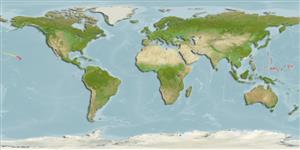>
Gobiiformes (Gobies) >
Gobiidae (Gobies) > Gobiinae
Etymology: Opua: A harbour in N. Zealand; in maorí; o = the place of + Pua = flower. It also exists the Hawaiian word opua = the house that catches the rain to substain our bodies; a poetic name for "clouds".
Environment: milieu / climate zone / depth range / distribution range
Écologie
marin récifal; profondeur 1 - 169 m (Ref. 58302). Tropical; 28°N - 4°N
Pacific Ocean: Marshall Islands and Hawaiian Islands.
Taille / Poids / Âge
Maturity: Lm ? range ? - ? cm
Max length : 4.4 cm SL mâle / non sexé; (Ref. 28618)
Description synthétique
Clés d'identification | Morphologie | Morphométrie
Épines dorsales (Total) : 6 - 7; Rayons mous dorsaux (Total) : 8; Épines anales: 1; Rayons mous anaux: 9. SL to about 40 mm.
Lives in shallow protected waters (Ref. 1602). Benthic on silty sand or mud (Ref. 58302).
Life cycle and mating behavior
Maturities | Reproduction | Spawnings | Egg(s) | Fecundities | Larves
Myers, R.F., 1991. Micronesian reef fishes. Second Ed. Coral Graphics, Barrigada, Guam. 298 p. (Ref. 1602)
Statut dans la liste rouge de l'IUCN (Ref. 130435)
Menace pour l'homme
Harmless
Utilisations par l'homme
Outils
Articles particuliers
Télécharger en XML
Sources Internet
Estimates based on models
Preferred temperature (Ref.
123201): 28 - 28.9, mean 28.7 °C (based on 14 cells).
Phylogenetic diversity index (Ref.
82804): PD
50 = 1.0000 [Uniqueness, from 0.5 = low to 2.0 = high].
Bayesian length-weight: a=0.01023 (0.00477 - 0.02194), b=3.02 (2.84 - 3.20), in cm total length, based on LWR estimates for this (Sub)family-body shape (Ref.
93245).
Niveau trophique (Ref.
69278): 3.2 ±0.3 se; based on size and trophs of closest relatives
Résilience (Ref.
120179): Haut, temps minimum de doublement de population inférieur à 15 mois (Preliminary K or Fecundity.).
Fishing Vulnerability (Ref.
59153): Low vulnerability (10 of 100).
